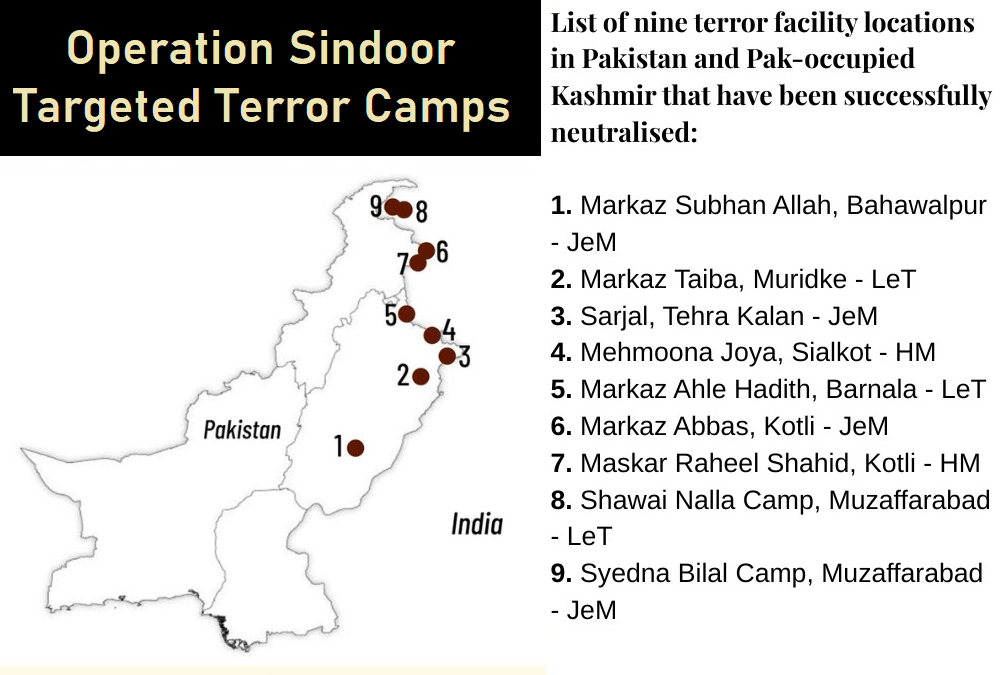
- Operation Sindoor is not a knee-jerk reaction but a carefully coordinated campaign involving the Army, Navy, Air Force, cyber units, and diplomatic corps.
- India projected its response not as an act of war, but as a legitimate counter-terrorism operation under international law, invoking Article 51 of the UN Charter that provides for self-defence.
- Operation Sindoor marked a tectonic shift in India’s national security doctrine, showcasing its Proactive Deterrence, Multi-Domain Warfare Readiness, Psychological Superiority and Enhanced Domestic Unity.
- The operation reinforced India’s claim to leadership in the Indo-Pacific and positioned it as a key pillar in maintaining peace and stability in the region.
At 1:44 am on May 7th, 2025, Indian armed forces unleashed Operation Sindoor-a surgical, retaliatory incursion deep into Pakistan-occupied territory in direct response to the Phalagam terrorist attack, carried out by Pakistan-based Lashkar-e-Taiba operatives and backed by the ISI. This assault, reminiscent of the October 7 attacks on Israeli civilians by Hamas, resulted in 28 deaths of tourists, mostly Hindus. India, after days of strategic restraint, launched a decisive and multi-pronged response codenamed Operation Sindoor – a name symbolising commitment, fortune and protection.
Precision and Purpose: Anatomy of Operation Sindoor
Unlike past limited retaliatory actions, Operation Sindoor was a full-spectrum military and strategic response. It was not a knee-jerk reaction but a carefully coordinated campaign involving the Army, Navy, Air Force, cyber units, and diplomatic corps. The operation unfolded in three coordinated phases:
- Kinetic Strikes: The Indian Air Force and special operations units conducted precision strikes on 9 terrorist camps, launch pads, and military installations across Pakistan-occupied Jammu and Kashmir (PoJK), including Bahawalpur, Muridke, Narowal. The IAF neutralised several radar and anti-aircraft batteries in strategic Pakistani military outposts, asserting aerial superiority.
- Cyber and Space Integration: India’s Defence Cyber Agency and Defence Space Agency launched preemptive strikes that disabled key ISI networks and disrupted Pakistani command-and-control systems. Real-time satellite imagery from India’s RISAT and CARTOSAT constellations enabled pin-point operations with minimal collateral damage.
- Maritime Mobilisation: The Indian Navy’s Western Command mobilised a forward strike group to patrol the Arabian Sea, ensuring strategic pressure on Karachi port and Gwadar, while also preventing the movement of reinforcements through the sea route.
India made a conscious decision not to strike any Pakistani military establishments, instead opting to deliver maximum punishment through surgical strikes on terror camps. This ensured escalation was controlled while the strategic intent remained unambiguous.

Strategic Messaging and Public Support
A key element of Operation Sindoor was its clear articulation of objectives to the global and domestic audience. India projected its response not as an act of war, but as a legitimate counter-terrorism operation under international law, invoking Article 51 of the UN Charter that provides for self-defence.
The Indian government’s communication strategy was robust. There was no ambiguity in the messaging—this was a direct consequence of cross-border terrorism. This clarity helped generate broad public support within India, even among states and civil society groups traditionally wary of conflict escalation. The global community, while calling for restraint, largely acknowledged India’s right to defend its citizens.
Pakistan’s Response Amid Internal Strain
Pakistan’s military response was largely conventional and limited to artillery fire and attempted intrusions in sectors like Rajouri and Poonch. These were swiftly repelled by Indian forces. Notably, Pakistan refrained from deploying its air force beyond token patrols, possibly fearing a wider escalation and internal backlash.
Internally, Pakistan struggled to contain the political fallout. Civil-military friction intensified, and widespread protests erupted in cities like Lahore and Peshawar against the military establishment’s handling of the situation. India’s calibrated but firm posture had managed to sow both psychological and operational disarray in Islamabad.
Pakistan’s attempts to garner international support found a lukewarm response. The Organisation of Islamic Cooperation (OIC) issued standard statements, but key Muslim-majority states like the UAE and Saudi Arabia refrained from openly criticising India. Even China, Pakistan’s closest strategic ally, called for restraint but stopped short of condemning India, indicating a growing strategic recalibration in Beijing vis-à-vis India.
Global and Regional Geopolitical Shifts
Operation Sindoor triggered a visible shift in regional and global geopolitics:
- Quad Cohesion: Australia, Japan, and the United States expressed solidarity with India and offered enhanced intelligence cooperation. The Quad’s naval exercises were quietly upgraded to include live surveillance sharing and anti-submarine warfare drills in the Bay of Bengal and Arabian Sea.
- France and the EU: France, already a key defence partner of India, endorsed New Delhi’s right to self-defence and offered logistical support in Indian Ocean surveillance. This was followed by quiet consultations within the EU on expanding strategic ties with India to ensure regional balance.
- ASEAN Realignment: Several Southeast Asian nations, previously neutral, began viewing India as a credible net security provider, especially in light of China’s muted response and Pakistan’s growing instability.
- Russia’s Cautious Neutrality: Moscow maintained strategic ambiguity, offering to mediate while refraining from taking sides—a signal of Russia’s increasing balancing act between India and China.
Implications for India’s Strategic Doctrine
Operation Sindoor marked a tectonic shift in India’s national security doctrine. Key outcomes include:
- Proactive Deterrence: The operation confirmed that India would no longer wait for provocations to escalate but would act preemptively against state-sponsored terror threats.
- Multi-Domain Warfare Readiness: India demonstrated its ability to integrate cyber, space, kinetic, and information warfare, setting a new precedent in regional conflict management.
- Psychological Superiority: The psychological impact of the operation was far-reaching, both in Pakistan’s military circles and among India’s adversaries across the region.
- Enhanced Domestic Unity: Unlike in the past, there was little political division over the operation. Across party lines, there was support for the government’s decision, reflecting a broader consensus on national security priorities.
Conclusion: A Defining Moment for India’s Global Standing
Operation Sindoor will be remembered as a watershed in India’s strategic evolution, a moment when the nation redefined its security red lines and firmly took control of the narrative. It was a warning to hostile actors, a reassurance to allies, and a signal to the world that India is prepared to defend its sovereignty with precision, purpose, and resolve.
In the broader context, the operation reinforced India’s claim to leadership in the Indo-Pacific and positioned it as a key pillar in maintaining peace and stability in the region. The geopolitical message was clear: India will no longer be reactive – it will be assertive, smart, and sovereign in its choices.
Saisha is pursuing a Bachelor of Diplomacy and Foreign Policy at the JISA, O.P. Jindal Global University. Her areas of interest include economics, business, diaspora studies, and diplomacy. Views expressed are the author’s own.
